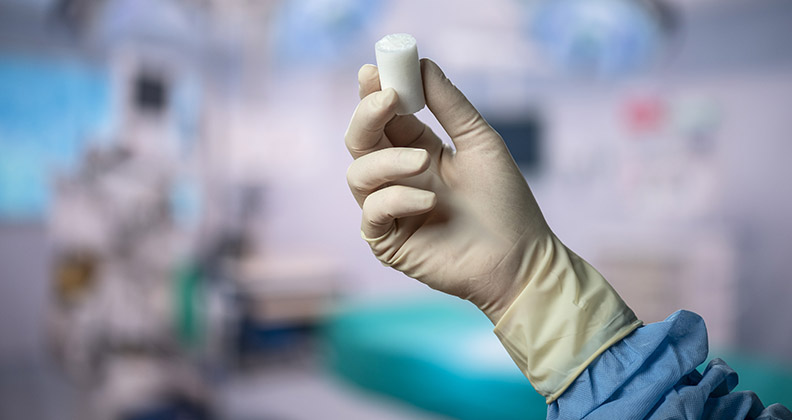
Conducting clinical trials during a pandemic presents a unique set of challenges, including patient access and employee safety. Thus, orthopedic companies have needed to quickly respond to the current environment by relying on technology to collect patient data.
Coming out of this landscape, lasting change is likely to emerge in some cases while traditional components will also remain. Flexibility and adaptability will be vital for orthopedic companies to be successful.
To learn more about the state of clinical trials for orthopedics, we gathered insight from three experts:
- Iman Ahmad, Senior Director Clinical Affairs, MCRA
- Michael Otlewski, M.S., Clinical Program Scientist, MED Institute
- David T. Novotny, General Manager & Global Head, Medical Device & Diagnostic Research, ICON
In what specific ways has COVID-19 affected clinical trials?
Ahmad: The biggest impact that we saw early on during the pandemic was that institutions had to close their doors for safety measures, and patients were not able to come back in for their routine study visits, so we were seeing those visits get delayed or missed. Also, new patients entering a trial had dramatically slowed down, and that trend continues.
FDA responded very quickly back in March when they put out a guidance to the industry for both pharmaceutical and device studies. Their recommendations helped guide sponsors who were running studies on how to consider patient safety, and did not penalize sponsors for the fact that there was inevitably going to be missed or delayed data.
One of the other big trends that we saw was the widespread adoption of telehealth visits. Patient-reported outcomes (PROs) to FDA are a very important part of primary and secondary endpoints for orthopedic studies. We were able to find ways to help the sites collect PRO data remotely.
There are still some things that have to be done in person, such as the actual surgeries and early post-op care. Given this, we’re seeing sponsors using hybrid trial designs, with a combination of traditional in-person visits and fully virtual follow-up visits where data collection occurs through telehealth appointments and remote data collection on phones and tablets.
Otlewski: Early on, trials were delayed because elective procedures were being postponed or canceled, and so the study procedures were not being done. Since then, we’ve seen that follow-up visits during trials are either delayed or canceled. And so, you have the data collection being pushed back until it’s safe for patients to come in to visit the trial sites, or the data just missed completely. If there were more defined follow-up windows that the trial had to follow, then they may have missed those time points.
So as a response, people have adopted a more decentralized approach to trials and data collection, where they can get as much as they can from the patients while they’re at home through telemedicine.
Novotny: Since the onset of the COVID-19 pandemic, social distancing measures and restricted travel have decreased patient mobility, direct and in-direct contact, and investigator and site availability, therefore disrupting clinical trials. These challenges will affect not only data collection and analysis, but also key study outcomes.
Additionally, as a result of limited travel, many clinical trials witnessed an initial decline in enrollment, which is now slowly increasing. In orthopedics, we saw enrollment dropping by 70% in February/March and now rising to about 50%. The pandemic also forced clinical trials to accept and accelerate the use of digital health technologies to alleviate disruptions and mitigate risks caused by the spread of the virus. These innovations have the potential to advance the future conduct of clinical research while offering additional benefits in cost containment, telehealth access and maintenance of quality oversight.
What advice do you have for orthopedic companies with trials in progress?
Ahmad: Based on the recommendations provided by FDA in their guidance, if a sponsor wants to use a hybrid trial design to add some flexibility to how data can be collected, there’s a two-step process that they have to complete: They have to change the clinical protocol, and have sites re-consent patients so that they understand which visits are in person, and which ones can be conducted remotely if needed. Working with a team such as ours that has regulatory expertise and knows how to present this modification to your clinical investigation plan to FDA and to your IRB can help get that done. Once you have that approval, it’s easy to pivot.
Now is a good time for sponsors of ongoing studies to make that modification to your protocol, if you haven’t done so already, so that you’re prepared for the winter, for a second wave, for whatever might come. That allows business continuity for your clinical research portfolios. Once you’ve added that flexibility, trained your sites, and everyone is on board and everyone feels comfortable knowing what the Agency is comfortable with, then you can proceed with this new paradigm.
Otlewski: The main thing is to just document, document, document any delays they’ve had or missed data or adjustments made to the trials specifically because of COVID for FDA and IRB. Oversight organizations are being very understanding about it, but the companies need to show what has changed and why, and justify it was because of COVID and how they’ve adapted.
Now would also be a good time to pare back from all the nice-to-have data to the need-to-have data. For qualitative endpoints like quality of life measures, consider providing those to the trial subjects at home. They can fill those out and submit them without having to come into the trial site.
For larger studies, it may be worth getting an E-Pro tool where the patients can log in on their phones, for example. For smaller studies, maybe it’s just phone calls to the patients to see how they’re doing and fill out their assessments that way.
Some endpoints are more quantitative or related to imaging, where obviously that can’t be done at home, and in those cases, there may be alternatives like finding a local imaging center where the orders can be sent from the trial site to the imaging center. And then the patient can go there if it’s closer to their home, rather than traveling. It’s all about cutting back on travel and finding ways to collect the data remotely when possible.
Novotny: Stay the course. Innovation must not cease, but we need to recognize and adapt to the environment we are currently in so that we can continue to bring technology and treatments to patients.
To mitigate disruptions from COVID-19, many sponsors are adjusting the study design from a statistical perspective. For example, companies may be in negotiations with FDA on alternative methods to show efficacy in lower numbers of patients. This trend to maximize the utility of data collected will continue, as data complexities rise, such as managing missing or lost data. Therefore, companies will need to develop statistical expertise. In fact, we’ve already seen an increase in requests for clinical trial design and regulatory expertise for ongoing clinical investigations.
So, as we move forward into continued uncertainty, we recommend building strategic partnerships with organizations that can provide these services as well as home health, direct to patient access and patient portal environments earlier rather than later to prevent further delays and potentially support a more innovative way of keeping studies on track.
How will clinical trials evolve over the next five years?
Ahmad: We’ve made clinical trial participation much more accessible, more convenient, more attractive by having remote “e-visits.” We’re likely to see an increase in recruitment and enrollment of participants, which used to be the hardest thing—80% of studies fail to meet that target timeline for recruiting participants. That becomes much easier when people who would have declined to participate are saying yes now that trial participation is less demanding from a time and travel perspective.
You can also improve patient engagement and compliance. Usually, about 40% of patients tend to lose interest and drop out of studies, which has a devastating impact on the endpoint analysis. Now, if it’s easier and there’s an incentive for filling out study questionnaires and having telehealth appointments for longer term clinical follow-up, patients are more likely to stay in the study. With the apps that are being used to communicate with patients, you can keep them engaged, you can keep them informed, you can show them their progress in the study, you can give them notifications about what tasks they need to perform next. The digital engagement with patients really helps with retention, and you get retention rates as high as 90% to 95% now, as opposed to 60% as the average.
I think there’s also going to be more of an ecosystem of software systems that are research-based and are integrated to support remote data collection. For example, the site’s EMR can be integrated with a telehealth video system, an imaging portal, and another portal for collection of data from patient questionnaires. You’re going to see more and more companies acquiring other companies to have a total turnkey solution to these kinds of hybrid trials.
Otlewski: It’s moving toward this decentralized notion. There are some assessments that just cannot be done remotely or at home, but there are a lot more tools now taking advantage of new technologies where they can collect these data points at home. There are nursing groups that can come visit the patients in their homes and conduct a lot of these assessments, or telemedicine options. The COVID-19 pandemic has really hastened the adoption of these things. We were starting to move that direction anyway, and then everyone has jumped on board out of necessity.
With the transition to the MDR regulations in Europe, a lot of products have been up classified to a higher class, which includes orthopedic implants, or for other reasons, the clinical data needs are increasing. And so a lot of products will need more clinical data than they would have before. That’s fueling this need for more efficient ways of collecting data, which hopefully are also more cost effective too.
Novotny: As fundraising for orthopedic startups has increased, we will see more of these young companies emerge. Further, clinical trials will continue to evolve to more decentralized models, which include leveraging digital and direct access technologies to enhance operational and data efficiencies. This model could also be an indicator for more cost-effective trials.
Given the rapid growth of IT, science and computing, clinical trials will also see more automated processes. As more of these digital elements are incorporated into clinical trials, we will see an acceleration of massive data sets, and more digital endpoints used to inform primary and secondary endpoints. Lastly, the pandemic made evident that agility will be required in clinical trial design to mitigate risks and adapt to change as crises — whether it’s the next natural disaster or pandemic — continue to surface.
HT
Heather Tunstall is a BONEZONE Contributor.




